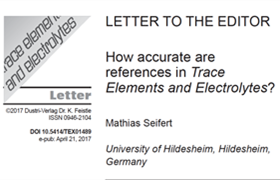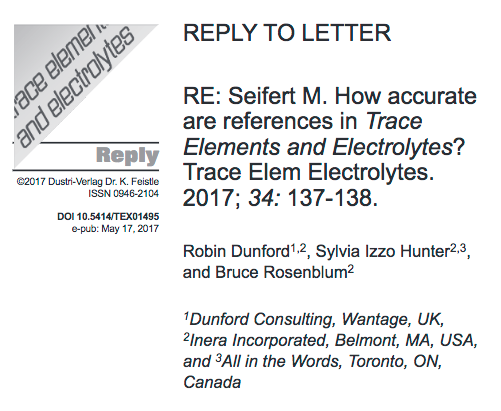November 10, 2017
How the Technology behind Edifix Helps Boost Reference Accuracy: The Case of Trace Elements & Electrolytes
Whether you’re a publishing professional, a journal editor, a researcher, or a software developer, it’s great to see your work achieve its goals out in the world. So we at Inera were delighted when our eXtyles customer Dustri-Verlag shared with us a letter to the editor of one of their journals, Trace Elements & Electrolytes (TEE), by Dr. Mathias Seifert of the University of Hildesheim, Germany. Dr. Seifert’s letter documents a thorough analysis of citation accuracy in TEE. Although previous studies of citation accuracy in scientific and medical journals (see here for references) have found error rates ranging from 8% to 66%, Dr. Seifert found an error rate in volume 31 of TEE of less than 5%—that is, just 31 of 643 references analyzed contained an error, which is well below the industry average.
To shed some light on what might explain TEE’s above-average reference accuracy, Dustri-Verlag kindly invited Inera to respond to Dr. Seifert’s letter. Before doing so, we conducted some data analyses and tests of our own, which found interesting patterns in the types of errors Dr. Seifert uncovered. The most important finding was that these errors were mostly of the kind that editorial software can’t resolve: errors originating with authors or publishers, or errors in sources not available online. This seems to suggest that Dustri-Verlag has reliably eliminated the kinds of errors picked up by editorial software such as Inera’s eXtyles, which Dustri has been using for some time. While eXtyles is certainly not the only factor driving TEE’s notable reference accuracy rate, it is likely a major contributor.
The Role of Software in Reference Accuracy
While some reference errors may seem minor—a one-digit discrepancy in a starting page number, a single word missing from an article title—even small errors can make the source material more difficult for readers to find. As more and more published reference lists become part of the Internet record and come up in online search results, inaccurate citations can propagate more quickly across publications, multiplying confusion and making the discoverability problem worse.
Of course, reference accuracy is a shared endeavor that relies on the careful work of authors, publishing staff, and freelancers. As we all know, however, everyone involved in publishing increasingly has more on their plates, and manual reference checking takes a great deal of time that most people simply don’t have—or reduces the time available for other key editorial tasks. Fortunately, while only humans can conduct research, restructure a confusingly worded sentence, or fact-check a manuscript, sophisticated software tools exist that can help improve reference accuracy.
eXtyles, used by Dustri-Verlag and many other publishers, automates repetitive copyediting tasks—including many related to reference accuracy—to save time and money. Although Edifix (which just turned 3!) is a relatively new product, its reference correction and linking functions rely on the same technology and algorithms that we designed for eXtyles and have been continually improving on for two decades. Edifix is a low-cost, scalable, cloud-based solution designed to achieve the same goal as the eXtyles reference processing modules.
eXtyles and Edifix can improve reference accuracy in two ways: first, by filling in missing information (e.g., page numbers) and correcting minor transcription errors (e.g., a missing word in an article title) based on curated PubMed metadata; and, second, by reliably identifying and flagging discrepancies between reference entries and the Crossref or PubMed metadata for the cited source, prompting the editor to investigate. This allows editorial staff to find and correct errors in an efficient, targeted way. Edifix takes over the high-volume cross-checking that is time-consuming for a human but can be done quickly and reliably by a machine. Integrated into the editorial process, software can not only save time and money but also improve the quality of editors’ work!
What else is needed to ensure reference accuracy?
As helpful as editorial software can be, its accuracy relies on curated metadata, which may be unavailable or can be corrupted at the point of origin. Our response to Dr. Seifert’s letter offers some concrete suggestions for further improving reference accuracy that go beyond what software can achieve alone.
Citation accuracy is key to scholarly communication, and we are always looking for ways to improve it. Thanks again to Dustri-Verlag and TEE for inviting us to participate in this discussion!
You can read both Dr. Seifert’s letter and our reply in PDF format. And if you’re looking to improve reference accuracy in your own publications, please contact us to learn how our software solutions can help.

